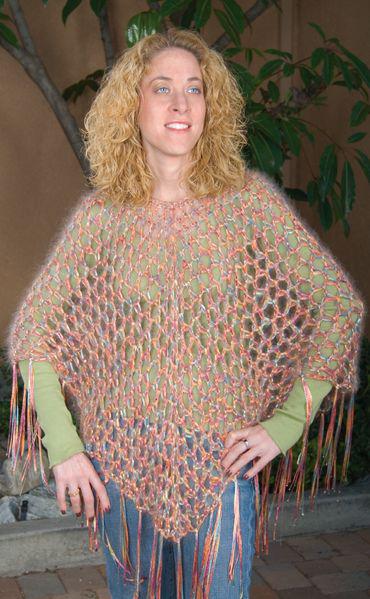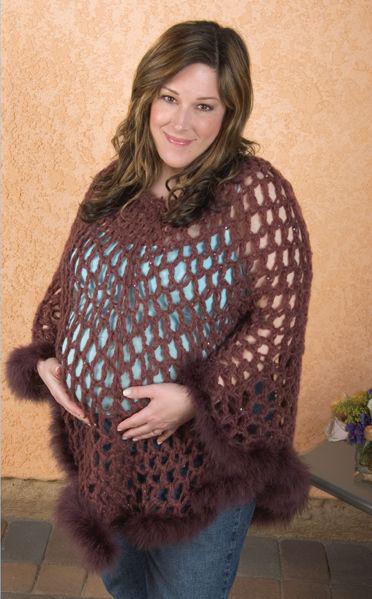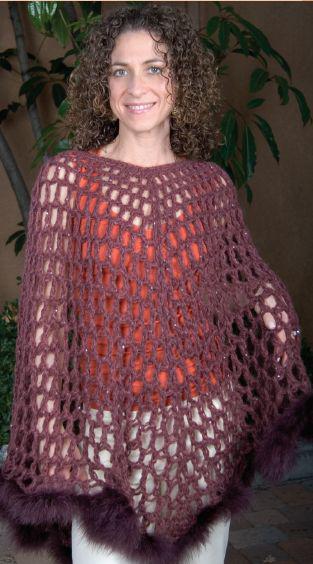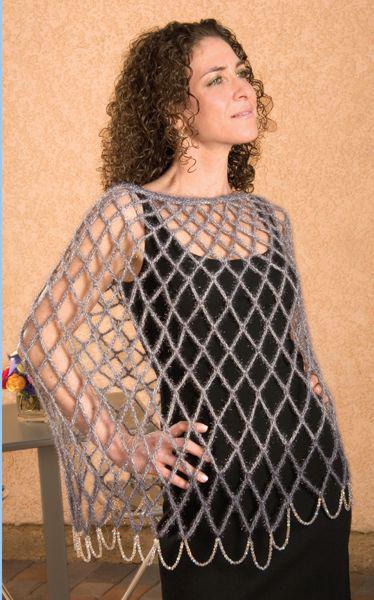Mother of Purl (27 page)
Authors: Edith Eig,Caroline Greeven


Natalie Eig
[Poncho with Feather Trim]
MATERIAL |
NEEDLES |
STITCH |
With 2 strands of Fiora and smaller hook, chain 40". Join with a slip stitch, careful not to twist. Place marker.
Sc in each stitch all around.
Start Pattern:
ROUND 1:
Dc in 1st st, chain 1, dc in the same st. Place marker in that st. ∗ Chain 1, dc, skip 1 st. ∗
Repeat from ∗ to ∗ to the middle of round. Dc, chain 1, dc all in the same st. Mark that st. Repeat until the end of round.
ROUND 2:
Dc, chain 1, dc in the first arch, ∗ chain 1, dc, skip 1 st ∗, repeat to second marked st. Dc, chain 1, dc in the same arch. Repeat from ∗ to ∗ until the end of round.
Repeat round 2 one more time. Change to larger hook. Keep repeating round 2 to desired length.
With smaller hook, tighten up neckline to desired width by sc as follows: ∗ 3 sc in a row, skip 1 chain ∗.
FINISHING
Sew Piuma along bottom edge of poncho.


[Poncho with Crystal Beads]
MATERIAL |
NEEDLE |

With 2 strands of Muguet, same color, chain 38". Join, careful not to twist. Place marker.
Single crochet in each chain.
ROUND 1:
∗ Chain 7, skip 7 ∗ across round.
ROUND 2:
∗ Chain 7, skip 3, join in 4th chain, skip 3, chain 7 ∗ repeat from ∗ to ∗ across round.
ROUND 3:
Repeat round 2.
ROUND 4:
Chain 9, repeat as above.
Work 3 rows, same as round 4.
ROUND 8:
Chain 11.
Work 3 rows even.
ROUND 12:
Chain 13, work 2 rounds.
ROUND 14:
Change to 2 strands of darker color, work 2 rounds. Fasten off.
With 2 strands of darker color, tighten up neck, if necessary, with a single crochet, 3 sts in a row, skip 1.
String beads, about 22 in each arch, forming arches at bottom of work.
Abbreviations:
The “language” of knitting. Directions are abbreviated into an easy–to–follow code, such as K2P2.
Backstitch:
One of the three methods of seaming a sweater we cover in the book.
Binding Off:
The final stage of knitting, where you “close” off the live stitches and take your knitting off the needle.
Binding Off in Pattern:
When knitting in rib or another pattern stitch, you must bind off in pattern (i.e., if you see a knit stitch, you knit; if a purl, you purl; and bind off accordingly).
Blocking:
The method of adding structure to your knitting by drying it in shape after either steaming it or submerging it in a warm water bath.
Bobbins:
Used in fair isle or intarsia knitting to control several different colored strands of yarn.
Buttonhole:
I teach the one–row method which produces a neater, firmer button hole than other methods.
Cable:
A repetitive vertical pattern created by crossing two or more stitches back and forth across two or more other stitches.
Cabling Needle:
When working a cable, the stitches that are being crossed are slipped onto this needle and held either in front of or behind the other stitches until it is time to knit them.
Cast On:
The process of creating your first row of stitches. There are several methods; I teach the two–balls cast–on.
Circular Needles:
Double–pointed needles that are fixed to each end of a long flexible piece of nylon or metal cord. They can be used to create a seamless, tubular piece of knitting.
Continental Style:
I teach “English” style; this is the “other” style of knitting. It’s tricky, though it can be fast once mastered.
Crochet Hook:
Crochet uses one needle with a hooked end to create a fabric. It can be useful to finish your knitting or to add borders.
Decrease:
The process of reducing the number of stitches on your needles. I teach a few methods, and care must be taken to select the correct one, as the decreases slant the stitches and can affect the look of your knitting.
Double–Pointed Needles:
Used to create a tubular fabric, such as socks. They can work a much smaller number of stitches than circular needles, which make them useful for finishing projects begun on circular needles, such as hats.
Drop Stitch:
A dropped stitch that has been worked deliberately for a visual effect, leaving a long “ladder” above it.
Dropped Stitch:
A stitch that has been accidentally dropped, creating a run in your knitting. You must pick up the stitch before you continue knitting.
Ease:
Sweaters are designed with varying amounts of ease, or room. A sweater designed to fit a 36–inch bust might actually measure 38 inches because of ease.
Felting:
A very popular technique, whereby knitting is agitated in hot water and the fibers form a thick, “felted” fabric. Used primarily for bags, mittens, and slippers.
Full Fashioning:
A very sophisticated way to work the decreases on a sweater, which adds a noticeable outline to the armhole and shoulder shaping.
Garter:
Knit on both sides.
Gauge:
The number of stitches per inch and per row. This is the crucial secret to successful knitting—you must achieve the correct gauge for your pattern.
Increases:
Adding stitches in order to shape a garment.
Knit:
One of two fundamental stitches, the other being the purl.
Knitwise:
Insert the needle into the stitch as though you are going to knit it.
Lace:
An openwork design, based around a repetitive pattern, that resembles lace. YOs and K2tog are used together to achieve this effect.
Make One:
My preferred method for increasing the number of stitches on your needle.
Mattress Stitch:
This is the main method of seaming I use, and I also refer to it as “weaving,” because that is essentially what you do.
Needles:
The core of your knitting kit, these are available in many materials and styles, such as bamboo, metal, plastic, circular, and double–pointed.
Patterns:
Patterns can be written out in words or presented in a more visual charted form. Either way, once you know how to read them, you’ll be able to knit them.
Picking Up Stitches:
A technique most often used on necklines, where you use your needle to draw a strand of yarn through the bound–off stitches at the top of your pattern pieces. These stitches are then knitted “up” to form a neckband.
Purl:
The second fundamental stitch.
Purlwise:
Insert the needle into the stitch as though you are going to purl it.
Repeats:
In order to correctly read a knitting pattern you must understand that not every stitch will be written out—if the same stitch is worked over and over again it will be written K2*K2P2*. The portion between the asterisks is repeated till the end of the row, unless specified otherwise.
Seaming:
The method by which you join the separate pieces of your knitting together. I teach three methods: mattress, backstitch, and three–needle bind–off.
Seed Stitch:
Knit and purl stitches are alternated in the same row, then in the second row you knit over the purl stitches and purl over the knit stitches.
Shaping:
Using decreases and increases to add curves and shape to your knitting, especially around the hips, waist, and bust.
Slip Stitch:
This is where you slip a stitch from the left needle to the right needle rather than knit or purl it. It is often used for a decorative effect.
Stitch Holder:
Essentially a very large safety pin, this is used to hold live stitches that are not being worked.
Stockinette:
Knit one row, purl one row.
Substitutions:
Patterns usually specify a yarn, but you can always substitute a different yarn—just make sure you can obtain the correct gauge with it.
Swatches:
A four–by–four–inch sample of knitting completed prior to beginning a project, it is used to ensure that your gauge is correct and that your yarn and pattern work well together.
Yarn Over:
The process of wrapping your yarn around the needle to add another stitch with a lacy effect.
K:
Knit
P:
Purl
tog:
together
YO:
Yarn Over
DP:
Double–Pointed Needle
SL:
Slip
dec:
decrease
inc:
increase
